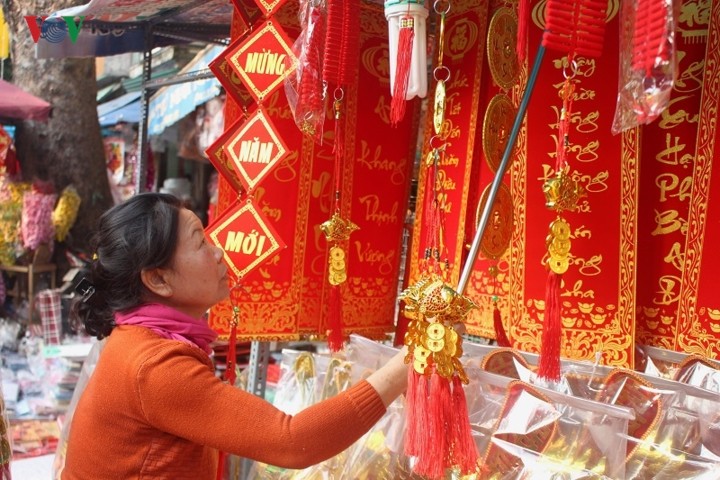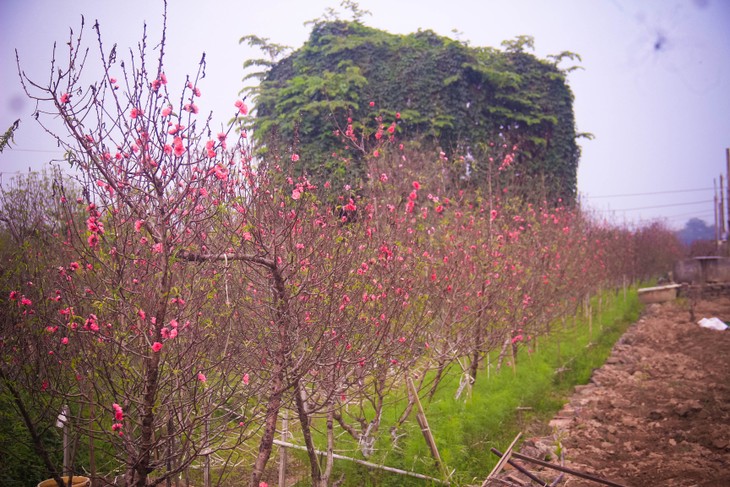B: Richard Nowak of the US told us he enjoyed the show on Monday which discussed the Lunar New Year festival. Richard wrote, “It is already beginning for most of Vietnam. VOV gave us a great insight into the traditions of the festival, including the custom of making offerings of fish, chicken, bamboo shoots, and sticky rice.”
A: Yes, for many Vietnamese people, Tet begins one or two weeks before the official celebration. If you listened to our program on Monday, you heard stories about the Land Genie and Kitchen Gods ceremony on the 23rd day of the last lunar month. Tet can be divided into three periods: before New Year’s Eve, New Year’s Eve, and the New Year.
B: There is a bustling atmosphere now as people shop, decorate their homes, stockpile Tet food specialties, and wrap up their business for the year.
 Flower market in Hanoi's Old Quarter opens for Tet 2019. Flower market in Hanoi's Old Quarter opens for Tet 2019.
|
A: Vietnamese people usually return to their families during Tet. Some return to worship at the family altar or visit the graves of their ancestors. People try to pay off their debts so they can enter the new year debt-free. Parents buy all family members new clothes in which to welcome the new year.
B: Vietnamese families usually have a family altar for paying respect to their ancestors. They prepare an offering tray of five fruits representing the 5 elements: metal, wood, water, fire, and earth. In the days leading up to Tet, each family cooks special holiday foods. One traditional Tet food is bánh chưng,a square sticky rice cake wrapped in leaves. Another very popular snack at Tet is mứt, candied fruit, served to welcome guests.
 Red is seen a symbol of luck during Tet. Red is seen a symbol of luck during Tet.
|
A: On New Year’s Eve, people stay up late to welcome the first moment of the new year, put on their new clothes, burn incense on the altar, pop a bottle of champagne, and enjoy their first meal of the year.
B: The first day of Tet is reserved for family. People wear their new clothes and exchange “lucky money” and wishes for health and prosperity. Everyone becomes one year older at Tet, so children wish their elders health and longevity- “a long life of 100 years”.
A: Some common wishes: Maya myriad of things go according to your will! May you enjoy abundant health! May money flow in like water!
B: Vietnamese believe that the very first visitor of the year sets the fortunesof the family for the year, so a successful person of good temperament and morality will be the first person invited into one’s house. If good things come to the family on the first day of the lunar New Year, it is an omen that the entire year will be full of blessings.
 Peach flower is a symbol of Tet. Peach flower is a symbol of Tet.
|
A: Sweeping during Tet is taboo, because it suggests possibly sweeping luck away. It is also taboo for anyone who recently lost a family member to go visiting during Tet. On the second and subsequent days of Tet, people visit extended relatives and friends and often stop at a local Buddhist temple to pray for blessings.
B: I’m reading an email from KP Muneer, a teacher at the Gulf Asian English School in the United Arab Emirates. He thanks VOV for sending him a 2019 calendar. Muneer listened to our program on January 22 on the frequency of 7220 khz, rating SINPO at 45434,indicating a good signal, no interference, minimal noise, and some signal fading but not too bad.
A: Andrew Sirani of Canada also received our Tet gift. He said: “Thanks for the beautiful wall calendar which arrived in the mail recently. It is hanging proudly near my shortwave radio listening station. I’ll be sure to keep listening and reporting on your shortwave broadcasts to North America.”
B: Radhakrishna Pillai of India thanked us for a New Year greeting card and VOV T-shirt. He commented: “My sincere gratitude to you for the interesting story about teacher Bui Van Binh, contemporary art at the National Assembly house, and Thuong Mo commune preserving Ca tru singing. All the reports were very interesting and paint a clear picture of everyday life in Vietnam. My congrats to VOV for your stories on India – India’s mint and mango chutney and Iyengar Yoga taking the West by storm. VOV creates new hope and aspiration in the Indo-Vietnam Friendship.”
A: I’m reading letters from Japanese listeners – Fumito Hokamura of Fukuoka province and Hayato Furukawa of Nagasaki city. Fumito tuned in to our program on January 6and listened to our Sunday Show about Vietnamese folk art. Fumito said he loves Vietnamese coffee and foods.
B: Hayato Furukawa reported listening to VOV on January 16th and rated SINPO all 4s. He thanked VOV for sending him a Tet present and said he will continue to listen to VOV’s Japanese and English programs.
A: Alexa Alcantara of the US sent a reception report for the program on January 27th on 7315kHz. He was able to hear voices clearly, with minor static, using a Tecsun PL-660. He commented: “It was interesting hearing world news and hearing another country talk about American news.”
B: Ivan Lebedev of Russia congratulated VOV on Tet 2019. “I hope it will be an incredible holiday with many interesting entertainments and games and, of course, bright fireworks. I hope the Year of the Pig will be very fruitful for good news from Vietnam and around the world, and a great year for the VOV staff.”
A:Radhakrishna Pillai of India wants to know about making Quang Phu Cau incense. Burning fragrant incense sticks is a must for religious rituals, because it creates a solemn atmosphere that connects people with spirits. Whether it involves a sumptuous or just a modest offering, worship must include burning incense sticks.
B: There are many incense villages across Vietnam. Craftspeople are now hard at work whittling, dying, and drying bamboo bark to make incense sticks ahead of the lunar New Year holiday. It is the most hectic time of year for workers in Quang Phu Cau village on the outskirts of Hanoi, where families have been making incense for more than a century.
A: Sales soar every year ahead of and during the Tet holiday in February. Most households in the alleys of Quang Phu Cau are involved in the ancient trade. Some hack bamboo planks and feed them into a whittling machine. Others dip the thin strips into buckets of pink dye, leaving hundreds of brightly coloured bushels fanned out like bouquets on the street to dry.
B:The dried sticks are coated with aromatic incense paste, redried, and shipped off for packaging. The village of Quang Phu Cau,about 40km from Hanoi, is just one of 1,000 villages specialized in this centuries-old craft.
B: Thank you all for listening to VOV and sending us your reports. We have verified them and will send you QSL cards soon. We welcome your feedback at English Service, VOVworld, Voice of Vietnam, 45 Ba Trieu Street, Hanoi, Vietnam. Our email address is englishsection@vov.org.vn. Thank you for listening to VOV on shortwave and following us online. Goodbye until next time.